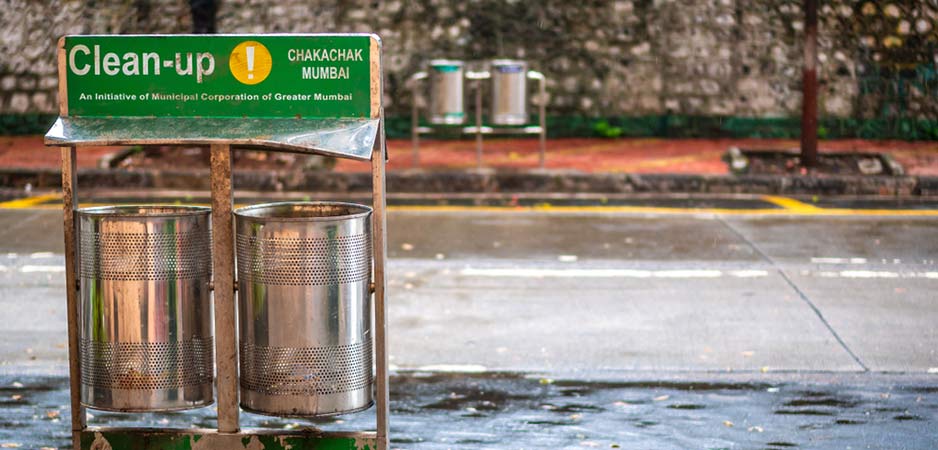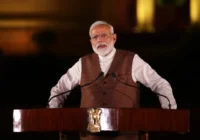This year was an unusually wet one for Mumbai, the commercial capital of India. Until mid-September, the city received rainfall of 2,366 mm, which is 26% more than the usual average of 1,800 mm. This is an ominous trend of extreme weather events, a phenomenon the frequency of which is rising because of climate change, according to scientists. Global warming triggers intense bursts of rainfall because higher temperature increases the moisture-holding capacity of the atmosphere. In urban areas, where impervious materials cover much of the land surface and hence lower natural infiltration of rainwater into the ground, such a heavy and short-term rainfall leads to flooding.
This year, the southwestern monsoon that typically arrives in Mumbai in early June came in late, leaving the city relatively dry for a month. But then the city received, within the span of two days, the same amount of rainfall it normally gets in the entire month of June. What’s more, in early July, Mumbai was hit with the worst rains in 14 years, leaving thousands of people stranded across the city.
Indian news outlets were full of images of people wading through knee-deep water. Cars were marooned across the city, roads were jammed, flights were canceled, and schools and colleges were closed. Excess rains have added to the woes of the city that has the dubious distinction of having the worst traffic in the world, as reported in a study by the location technology firm TomTom earlier in the year.
Down the Drain
Mumbai’s rains are a perennial torture. The city saw massive floods in 2005, in which around 5,000 people died, and the situation has only gotten worse since. Not surprisingly, people are embittered, and in the crosshairs of their anger is the Brihanmumbai Municipal Corporation (BMC), the richest civic body in India with an annual revenue of 300 billion rupees (over $4 billion) and over 750 billion rupees in accumulated reserves. The city’s residents blame the corporation for failing to fulfil its promises.
The BMC has spent considerable time highlighting its efforts to improve the archaic drainage system in Mumbai. It spent 5 billion rupees this year alone on laying new drainage lines, augmenting the older lines, desilting sewers and cleaning gutters. So why have all these efforts literally gone down the drains during the monsoons? It would be interesting to flip the mirror and look at the other side.
During a routine clearing of the drains in Kurla, a suburb of Mumbai, in August, workers fished out a cupboard, a table, a bed and mattresses, among other objects, which were choking the drainage system. Kurla adjoins Dharavi, considered to be one of the world’s largest slums, and has a population density of over 50,000 people per square kilometer. The area has several open drains besides the ironically named Mithi (sweet) river — one of the four suburban rivers in Mumbai passing through it. Mithi originates in the Vihar and Powai lakes in north Mumbai and runs a distance of 17.8 kilometers before draining into the Arabian Sea at the Mahim Bay. In ideal conditions, it should serve as a crucial storm-water drain for Mumbai during excess rainfall, when the two lakes overflow. But in reality, the river is a putrid drain regularly used by residents as a dumping ground for waste.
Workers claim broken water pipes and bamboo pieces — besides the occasional large items of furniture — are regularly dumped by the residents. Not surprisingly, the river pushes out years’ worth of garbage every time it rains. On August 4, the river flowed 4 meters high — almost half a meter above its danger mark — and the BMC had to evacuate over 400 people from the slum along the riverbank in Kurla among fears that homes would get submerged.
It Takes Two
Apathy to civic infrastructure is not restricted to slum-dwellers alone. In fact, littering and dumping garbage on the roads and footpaths is quite commonplace. Every day Mumbai dumps between 80 and 110 metric tons of plastic waste into drains and water channels, according to Vanashakti, an environment group. The BMC attempted to prevent people from tossing garbage into the open drains by covering some of them using polycarbonate sheets. But such methods restrict regular cleaning, and a similar covering of the suburban rivers such as the Mithi is neither practical nor allowed by the environmental regulations as that would affect marine life.
The attempt to control waste generation itself by banning single-use plastic and introducing steep fines for its use has also proved to be a futile exercise so far. One reason is that people prefer to buy fruits and vegetables from hawkers and roadside vendors who still use plastic bags. A change in habits — such as carrying a cloth bag — is proving difficult to achieve, despite multiple attempts to increase awareness of how plastic waste clogs the city’s drainage system besides causing long-term environmental damage.
Instead of playing the blame game, what Mumbai needs is for municipal corporations and citizens to take collective responsibility in keeping the city’s drainage infrastructure clean and efficient. It is important for the BMC to educate and engage with residents, especially those living in slums along the major drains, many of whom may have never given a thought as to how their own actions create the very problem that plagues them. The BMC also needs to put in place efficient programs for debris management. Citizen groups, on their part, should come together to increase awareness of the ills of plastic bag usage and public littering.
Mumbai doesn’t need to look far for inspiration. When Surat, a city 300 kilometers north of Mumbai in the state of Gujarat, was ranked as the fourth cleanest city in India in 2017, not many recalled it was once among the dirtiest and was even affected by the pneumonic plague in 1994. One should hope that Mumbai won’t wait for the plague to turn things around.
The views expressed in this article are the author’s own and do not necessarily reflect Fair Observer’s editorial policy.
Support Fair Observer
We rely on your support for our independence, diversity and quality.
For more than 10 years, Fair Observer has been free, fair and independent. No billionaire owns us, no advertisers control us. We are a reader-supported nonprofit. Unlike many other publications, we keep our content free for readers regardless of where they live or whether they can afford to pay. We have no paywalls and no ads.
In the post-truth era of fake news, echo chambers and filter bubbles, we publish a plurality of perspectives from around the world. Anyone can publish with us, but everyone goes through a rigorous editorial process. So, you get fact-checked, well-reasoned content instead of noise.
We publish 2,500+ voices from 90+ countries. We also conduct education and training programs
on subjects ranging from digital media and journalism to writing and critical thinking. This
doesn’t come cheap. Servers, editors, trainers and web developers cost
money.
Please consider supporting us on a regular basis as a recurring donor or a
sustaining member.
Will you support FO’s journalism?
We rely on your support for our independence, diversity and quality.






